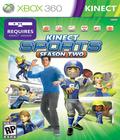Simple sports games have almost become a requirement for motion controllers since the Wii's popular Wii Sports. Both Sony and Microsoft have made similar sports titles for the Move and Kinect, respectively. In the case of Kinect Sports, the game wasn't packed in with the device, but its approach to simple and fun gameplay ensured that people picked it up with their new controllers, making it one of the top titles for the peripheral. A year later, Microsoft and Rare decided the time was right for a sequel that not only featured technical improvements but also brand new sports. The question is whether Kinect Sports: Season Two is worthy of your attention.
Like the previous game, Season Two focuses on six different sports: baseball, darts, football, golf, skiing and tennis. With the main mode, every sport can be tackled solo against three different opponents of varying difficulty. They can also be played with another player either offline or online. With the exception of one sport, all of the sports have a minigame variation. At the completion of every event, you get points based on your activities, so you can level up your character and keep a tally of how many calories were burned for the event and overall play session. Games like this live or die based on the offered sports and the delivery. Based on what's here, Season Two isn't as smooth as expected.
Football is a sport with both pluses and drawbacks. The game is a truncated version of American football with four short quarters. After receiving a kickoff, you have four downs to either run the ball in for a touchdown or kick a field goal. In single-player mode, you take on the role of both quarterback and receiver while the two-player game splits up the duties. To simplify things, you only have six plays to choose from, each evenly split between short, medium and long passes.
If you'd rather not choose, you can have the coach select the play, though you can overrule his decision. At the line, you can call an audible to change plays or just go with what was chosen. Crouching means you're ready, while standing up hikes the ball. You have a bit of control over who you're throwing to and, if you play exclusively as the receiver, you have to try a catching motion to make the catch. While your character will automatically run, doing some extra running will give him an extra speed boost.
As far as the basics are concerned, there isn't the sort of dynamism you'd expect from a football game. Quarterbacks can only pass or get tackled. They can't run the ball or try to evade the tackle if a defender gets through. They also can't call for running plays, so your offense is limited to the various passes. No matter what you try to do, you can never get him to do things you'd see in the real sport, such as stiff arm, spin, juke or jump over defenders. All you can do is run and hope the tacklers miss, which is unlikely since defenders move much faster than normal before slowing down and tackling you.
The biggest grievance against football comes from the fact that you can't play defense. Once the ball is out of your possession, you simply watch a chart that shows the progress of the other team through four downs before you gain control of the ball again. Leaving out what is practically half of the game makes the sport feel rather incomplete and less fun to play. Finally, unlike the other sports in the game, this one contains no minigame variant. It's the full sport or nothing.
Baseball is a big addition for this year's game, and unlike football, this truncated version feels like it has more options. You play only a few innings of baseball instead of the full nine-inning set, but you get to play both sides of the action. On offense, you take a swing at the balls or, if you're not feeling confident, call in a pinch hitter who has a better chance of hitting the ball out of the park. In case the hit ball stays in the park, you have to run to beat the throw, and you can slide to have a better chance of making it to the base. Once you've accumulated three outs, you change to defense.
As the pitcher, you'll be told which kind of balls the batter hates and try your best to throw those to ensure strikes. You can throw any balls you want, and you can throw everything from fastballs to slow curves to sliders. If the ball is hit, you take control of the outfielder, who catches the ball before it hits the ground. Should you fail, you have to throw it to a base and hope it's in time. The minigame is the standard hitting gallery, where you try to make the most points by hitting the ball in designated areas.
Season Two is still limited in a few areas. You can only produce two types of hits: singles and home runs. There's no opportunity to hit for doubles or triples, and bunting is almost impossible. Defensively, this prevents you from making double plays, though you can choose who you want to be out if you fail to make the catch in the outfield. All of the balls you throw will either get hit or result in strikes, and you can't intentionally bean the batter no matter how hard you try. What's here works out better than football since you can play both sides of a match, but the lack of options limits the game if you crave something with more substance or strategy.
Darts may seem like an unusual choice because it doesn't require much physical activity. The traditional game has you and an opponent playing, each with a score of 501 points. The objective is to be the first to drag the score down to exactly zero, and the first to do that in two games is declared the winner. This game does a great job of explaining how the scoring goes and how one is supposed to finish the game. For once, players can play properly instead of just throwing blindly. The minigame is a variation of the standard knife-throwing routine you see at a carnival or the circus, where you have to throw your darts to pop balloons and hope you don't hit the mascot instead.
Throwing darts is similar to some Kinect-based shooting games. You control an on-screen cursor using your hand. Once you find the spot you want to throw to, you pull your forearm back to initiate the lock. You then push forward to release, with the strength of the push determining how well the dart stays on course.
Darts exemplifies the improvements with the controls, namely the ability to detect more than just big, wide movements. The controller has always done a good job of detecting where the hand is, but the slight differences between pulling back and pushing forward on the arm are read well. There are times when the detection is off and it locks into place thinking you're doing the pull motion, but your corrections never trigger the push motion so accidental throws don't happen. Beyond that, the game does a good job of detecting throw strength, and while it will take some practice to pull off more accurate throws, the detection is good enough that you can have a very competitive game.
Golf is also deceptively simple. Standard golf rules apply in that taking fewer strokes to put the ball in the hole results in a better score, but some simulation aspects are included. The caddy often recommends which hit to take based on wind direction and strength. You can put your hand to your brow to zoom in on where the ball would go, and you can take a number of practice swings before committing to it. You can even change clubs to influence how far or short you want the ball hit in correspondence to the power of your swing. You don't see this type of thing with many casual golf games, and it's great to see it here since there isn't a serious golf sim for the Kinect yet. The minigame is unusual, as you stand on a yacht and try to hit various floating greens. The score depends on the zone where the ball lands.
If anything, the controls for this demonstrate how far Kinect controls have come after one year. Minute steps either left or right can be read accurately by the device, so there is the ability to fine-tune hit direction. The same goes for swing types, and even though it only registers three swing power levels, it can be more accurate if the game were a sim. The other additions are quite helpful, such as the color change for the putting line when determining the likelihood of the shot. Even though there are only nine holes in the main game, the accuracy with which it detects your movements and actions makes this one of the sports you'll play when the Season Two disc is in the console.
Skiing is the next sport that shows off how to make a simple formula work. The basic game is a slalom course, and though there are three different tracks, the goal remains the same. You have two heats, and the winner is the one with the fastest time on the course. Since this is slalom, you have to pass through every gate or take a one-second penalty for each miss. Hitting the gate counts as a pass, but doing so slows you down, though you gain more speed if you make perfect jumps and tuck your body. For this sport, the minigame is a copy of the obstacle course event in Kinect Adventures. As you go downhill, you shift your body to avoid objects and duck and jump over them. You're given a limited number of chances, with one taken away when you hit an object. The game ends once all of your chances have been taken away.
Despite the number of times that downhill racing has been represented on the Kinect, this version works well because of proper detection. Minute shifts in direction can be detected, and it feels much easier to determine the sharpness of your turn. The responsiveness of the controls means less fighting, so it feels controllable even at full speed. With its ability to handle basics well, there isn't much to complain about here.
Tennis is exactly what you expect it to be. The game is played with traditional tennis rules, with the goal of being the first to win two games. It does everything you expect, but the ability to argue a bad call throws an interesting twist on the proceedings. The minigame has you trying to hit all of the mascots with tennis balls in a certain amount of time, with time extensions given for hitting consecutive mascots without missing.
Like football, tennis ends up being one of the least desirable games in the package because of a myriad of issues. You can't initiate movement of your character at all, so there's no opportunity to be out of position to hit the ball. There's also no control over where the ball will go, so hitting in either direction feels futile. The biggest issue is that you can make the game feel effortless. Thanks to the automatic nature of both movement and hitting, you can simply stick out your arm to reach every volley, greatly reducing the challenge. Once discovered, that flaw alone diminishes the fun factor, and since this is so similar to last year's table tennis, which was done much better, one has to wonder if the efforts could've been better expended on another sport instead.
Quick Play pits one randomly chosen mascot against another in six rounds of randomly selected sports. Instead of taking on the traditional sports modes, however, the game has you duking it out in each of the minigames, resulting in some very fast rounds. Like before, mascots only vary in look, so you won't really get any boosts or detriments if you play as a shark, firecracker, zombie or a large can of soda. One interesting difference is that you don't necessarily have to obey the choices the first time out. Should the game chosen not be to your liking, you can spin the wheel again and hope that you get something more favorable when it stops.
Multiplayer play is quite good both offline and online. Aside from football, which only features co-op play, all of the other games are adversarial affairs. Offline play requires a little more space than before to ensure no one gets hit, but the game handles it well without mistaking one player for another. Online play has no lag and performs just as well as offline multiplayer games. Both represent the ideal ways to play the game, though offline multiplayer is the only way the minigames can be immediately played against others. Immediate online play is only restricted to the sport and not the associated minigames.
Aside from the familiar modes, there is a new one. Challenge mode has you playing multiplayer against a friend, but it's more indirect. Essentially, you choose from one of the five minigames or a special course of golf and play the game yourself. You then rack up a score and, if you're satisfied with it, send the challenge to your friend, who has to beat it. Challenges don't have to be played by the opponent immediately, but they do have a time by which they need to be completed before a winner can be declared. In essence, they've turned minigame multiplayer into a more casual e-mail affair; oddly enough, that works well considering these minigames are rather short and don't warrant the time spent connecting to and disconnecting from an opponent. Whether this sort of thing catches on outside of a smartphone environment is hard to determine, but the developers have to be applauded for trying something different for casual players.
Not much has changed graphically. The game still uses Avatars as your characters, and aside from the odd glitch in the detection where limbs sometimes get twisted, they animate well. The environments go with the cartoon-like scheme, so things are brightly colored instead of being dark. Those environments sport plenty of detail, with the dart studio and baseball stadium standing out as being filled with Avatars of all types. This time around, a lack of antialiasing is noticeable, especially when you look at diagonal lines, but otherwise, it looks almost the same as the first game.
The original game had some great audio, and Season Two is no different. The announcers seem to be localized for the given sport. Baseball and football have American announcers while darts has an Australian announcer, and a Scottish one is used for golf. Their vocal inflections are perfect for each sport, delivering hushed tones when needed and genuine excitement when something goes right. Some phrases are repeated often, especially in football when calling plays, but it doesn't become too bothersome. The menu music sounds the same as the first game — minus the vocal chanting. It becomes good background noise, but it won't stick with you once the power is off. Like the first game, snippets from real songs are used for every replay, victory or special event, like a home run in baseball. You'll hear some of the same stuff from before, like Amerie's "One Thing," but now it's mixed in with a variety of new songs. Stuff from Chubby Checker, David Bowie, The Hives and even Rick Astley pop up, and their inclusion adds some superfluous but welcome polish to the game.
In keeping with the current trend of Kinect games, the game couples voice controls with traditional menu controls. With the exception of going into Extras on the main menu, every menu option seen can be navigated with voice commands, which are initiated once the word "Xbox" is heard. Voice navigation extends beyond the menus and into the games, where no trigger word is needed before saying the command. In some situations, this is a novelty, such as in football when you hike the ball or select plays. Other times, it becomes necessary like challenging a call from the line judge in tennis since no gesture command is linked to that action. For the most part, the commands work well and are easy enough to initiate, so you'll find yourself using them more than gesture commands. There are times, though, when it fails to pick up the vocal command and repetition is needed, but overall, the use of voice works rather nicely.
In the end, Kinect Sports: Season Two doesn't feel as exciting as the original game. That lack of enthusiasm can be contributed to both football and tennis, with football only feeling like half a sport and tennis feeling like a simpler rehash of table tennis from the first game. Everything else feels fine and, combined with the minigames, makes for some good casual sports offerings. Together with the first game, it makes for a nice complementary title, but on its own, it doesn't stand up as well. It makes for a great rental or purchase if you can get it for cheap, but unlike the first game, it doesn't feel like a valued full purchase.
Score: 7.0/10
More articles about Kinect Sports: Season Two











 With six new sports to jump into and enjoy, Kinect Sports: Season Two pulls the whole family off the couch and turns your living room into a sports arena where intuitive, full-body gameplay and friendly competition reign supreme.
With six new sports to jump into and enjoy, Kinect Sports: Season Two pulls the whole family off the couch and turns your living room into a sports arena where intuitive, full-body gameplay and friendly competition reign supreme. 




































